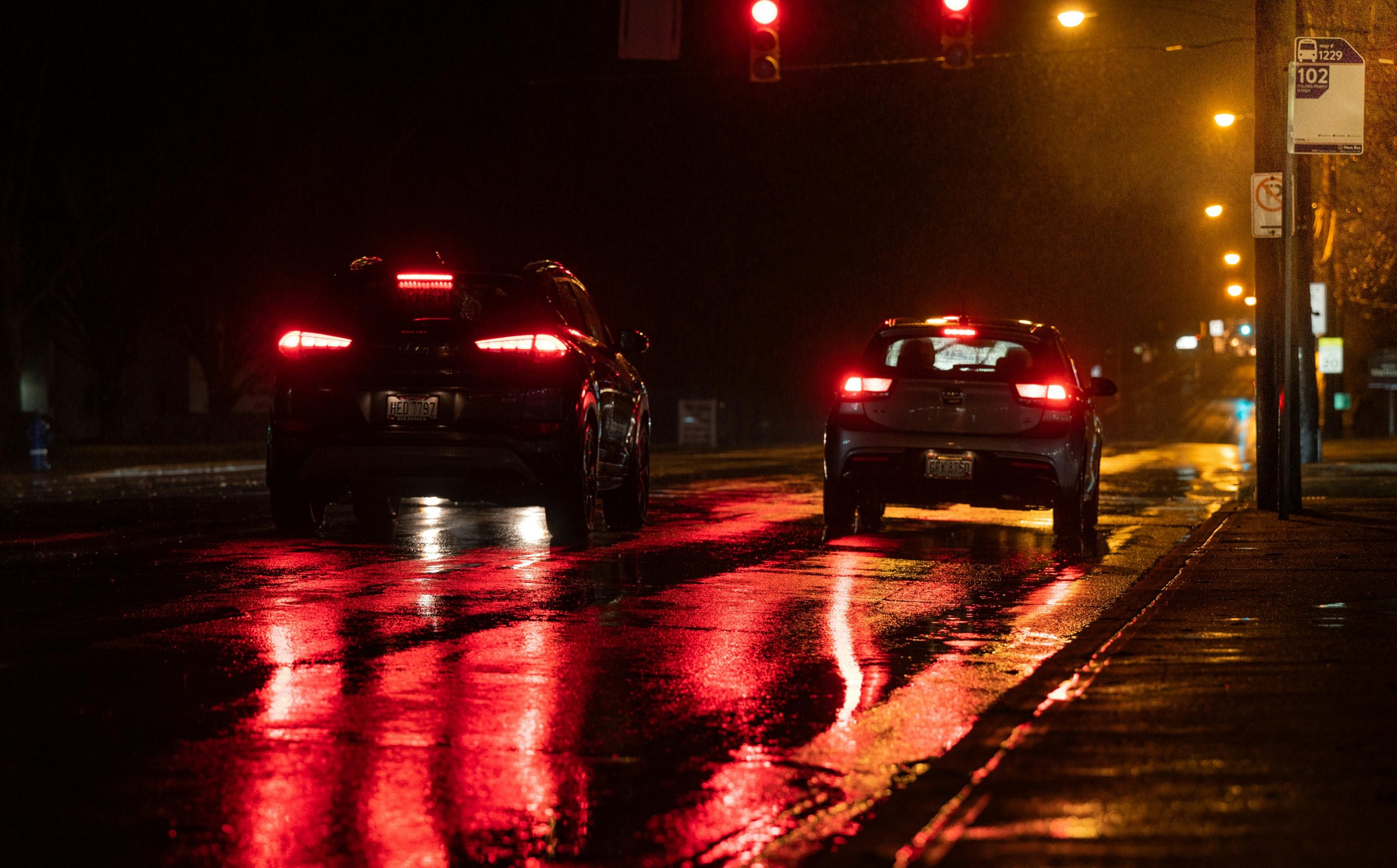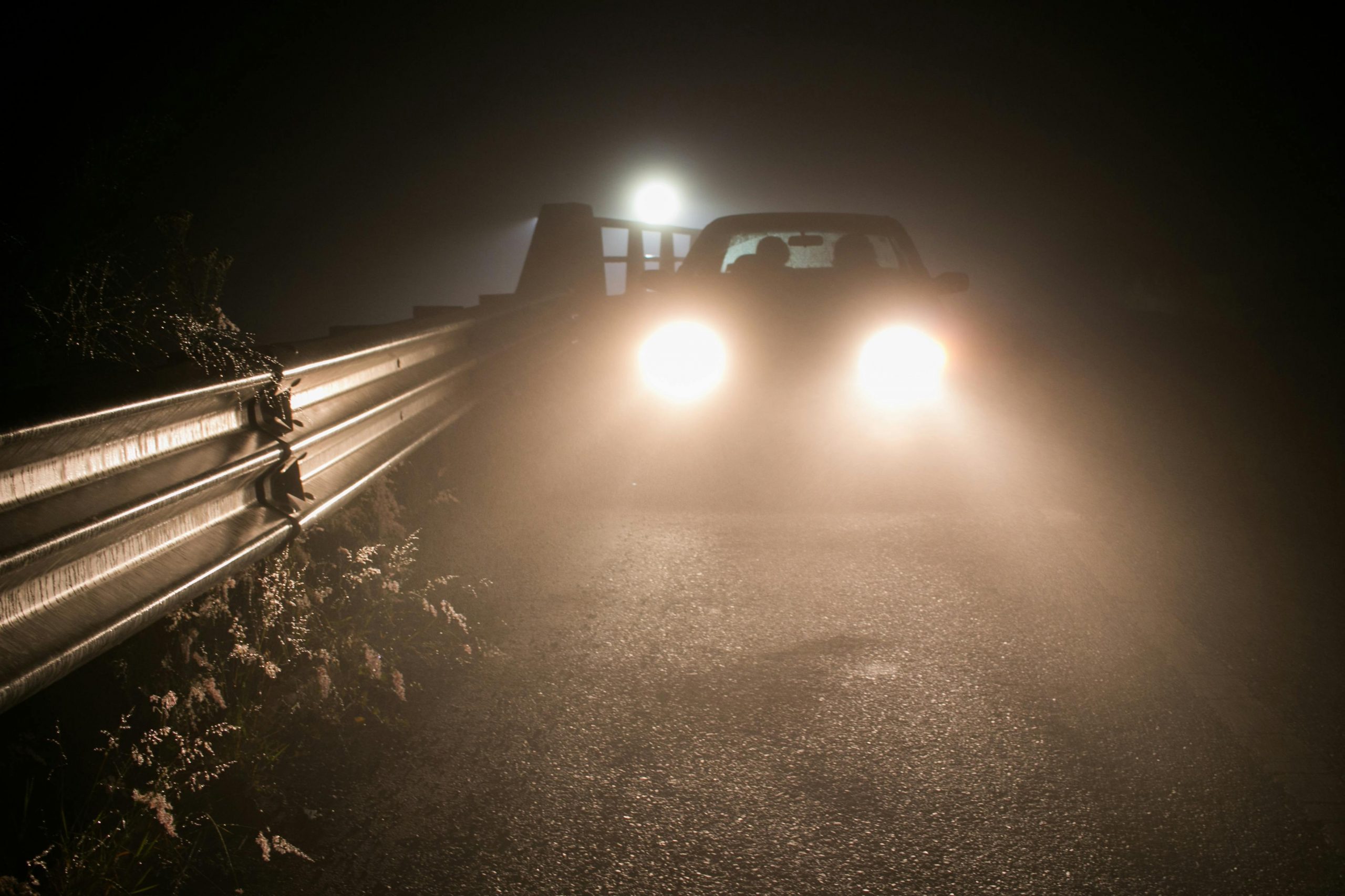Highlights
- Ensure your vehicle is properly maintained, especially lights, tires, and windshield wipers.
- Reduce speed and maintain a safe following distance in low-visibility conditions.
- Use headlights, fog lights, and reflective gear responsibly to stay visible.
- Minimize distractions and avoid driving when fatigued.
- Stay aware of environmental hazards like rain, snow, fog, and glare.
- Keep an emergency kit in your vehicle for unexpected situations.

Introduction: The Risks of Nighttime and Low-Visibility Driving
Driving at night or during low-visibility conditions poses unique challenges that increase the likelihood of accidents. According to the National Highway Traffic Safety Administration (NHTSA), a significant percentage of vehicle collisions occur during nighttime hours, despite fewer cars on the road. Limited visibility, glare from oncoming headlights, and driver fatigue all contribute to increased risk.
Whether you’re driving through poorly lit rural areas, navigating foggy highways, or contending with heavy rain, awareness and preparation are key. The purpose of this article is to provide detailed, practical guidance for drivers to prevent accidents during nighttime or low-visibility driving, helping you stay safe and confident on the road.
Understanding the Challenges of Night and Low-Visibility Driving
Before taking steps to prevent accidents, it’s important to understand why nighttime or low-visibility driving is riskier:
- Reduced Visibility: Darkness, fog, rain, or snow limits your ability to see obstacles, road signs, and other vehicles.
- Depth Perception Issues: Judging distances and speeds becomes more difficult, especially when headlights create glare.
- Glare from Oncoming Vehicles: Headlights, streetlights, or reflections can temporarily blind drivers.
- Driver Fatigue: Nighttime driving often coincides with natural circadian dips, leading to slower reaction times.
- Environmental Hazards: Wildlife, debris, and poorly marked roads are harder to detect.
Key Challenges:
- Limited reaction time due to poor visibility
- Difficulty gauging speed and distance
- Increased likelihood of collisions due to glare
- Higher risk of accidents in adverse weather conditions
Understanding these challenges lays the foundation for safer driving strategies.
Preparing Your Vehicle for Low-Visibility Driving
Proper vehicle preparation is essential for safe nighttime and low-visibility driving. A well-maintained vehicle significantly reduces risk.
Checklist for Preparation
- Headlights and Tail Lights: Ensure all lights are functioning, clean, and properly aligned to illuminate the road without blinding other drivers.
- Windshield and Mirrors: Clean glass surfaces and check wiper blades for streak-free visibility.
- Tires: Inspect tread depth and maintain correct inflation to reduce the chance of skidding.
- Fog Lights: Use appropriately in fog or heavy precipitation to increase visibility.
- Modern Safety Features: Utilize adaptive headlights, night vision systems, and lane departure warnings if available.
Pro Tips
- Regularly replace burnt-out bulbs and check headlight alignment at least twice a year.
- Keep a microfiber cloth in your car for quick cleaning of lights and mirrors during trips.
- Avoid tinted windshield areas that reduce nighttime visibility.
By ensuring your vehicle is properly maintained, you create a solid safety foundation.
Adapting Your Driving Habits
Even a well-maintained car requires safe driving habits, especially in challenging conditions.
Practical Habits for Night and Low-Visibility Driving
- Reduce Speed: Slower speeds give you more time to react to sudden obstacles.
- Maintain Safe Following Distance: Increase space between vehicles to account for delayed braking response.
- Minimize Distractions: Avoid using phones, infotainment systems, or engaging in distracting conversations.
- Avoid Fatigue: If you feel drowsy, pull over and rest before continuing.
- Plan Your Route: Stick to familiar roads with proper lighting whenever possible.
Safe Driving Habits:
- Keep both hands on the wheel and eyes scanning the road.
- Use high beams responsibly when roads are clear and switch to low beams when another vehicle approaches.
- Anticipate curves, intersections, and potential hazards.
Adapting your habits to the environment helps mitigate risks associated with nighttime or low-visibility conditions.
Handling Glare and Oncoming Traffic

Glare from headlights is a major contributor to nighttime accidents. Proper techniques can reduce its impact.
Glare Reduction Strategies
- Look slightly to the right edge of the road rather than directly at oncoming lights.
- Use anti-glare mirrors to minimize reflected light.
- Avoid sudden movements or veering in response to glare.
Common Mistakes
- Flashing high beams at oncoming drivers inappropriately.
- Failing to adjust speed to compensate for temporary blindness.
- Driving too close to lane markings to avoid glare, risking off-road accidents.
By controlling how you react to glare, you maintain control of your vehicle and reduce accident risk.
Driving in Fog, Rain, and Snow
Low-visibility driving often coincides with challenging weather conditions.
Fog
- Use low beams or fog lights; high beams reflect off fog and reduce visibility.
- Reduce speed and follow road markings carefully.
- Keep windows clear to prevent condensation from reducing visibility further.
Rain
- Slow down to prevent hydroplaning.
- Ensure windshield wipers are effective and tires have good tread.
- Maintain extra space from vehicles ahead to accommodate longer stopping distances.
Snow and Ice
- Clear all snow and ice from lights, mirrors, and windows.
- Accelerate and brake gently to maintain traction.
- Carry traction aids like sand or kitty litter in the car for emergencies.
Emergency Precautions:
- Keep a flashlight and reflective gear in your vehicle.
- Know safe locations to pull over if conditions worsen.
- Avoid unnecessary travel during extreme weather events.
Weather awareness combined with careful driving reduces the likelihood of accidents.
Using Technology to Stay Safe
Modern vehicles offer features designed to enhance nighttime and low-visibility safety.
Key Technologies
- Automatic Headlights: Adjust brightness and direction based on lighting conditions.
- Lane Departure Warning: Alerts you if you drift from your lane.
- Blind-Spot Detection: Helps prevent collisions when changing lanes.
- Forward Collision Warning and Emergency Braking: Detects potential hazards and assists in braking.
Smartphone Apps
- Navigation apps can highlight hazards, traffic congestion, and accident-prone areas.
- Roadside assistance apps can connect you quickly to emergency services.
Caution: Technology is a supplement, not a replacement for attentive driving. Always maintain situational awareness.
Defensive Driving Tips
Defensive driving is especially crucial when visibility is limited, such as during nighttime, fog, rain, or snow. It involves being proactive and anticipating potential hazards rather than reacting after a situation occurs. By adopting defensive driving habits, you increase your ability to prevent accidents and stay safe in challenging conditions.
Techniques
- Stay alert and anticipate the actions of other drivers. Pay attention to other vehicles on the road, including their speed, lane position, and potential blind spots. Anticipating sudden braking, lane changes, or erratic behavior allows you to react safely.
- Avoid tailgating and maintain extra space for reaction time. Limited visibility reduces your ability to judge distances, so increasing the distance between your vehicle and the one ahead gives you more time to stop or maneuver if needed.
- Scan the road 10–15 seconds ahead to identify potential hazards early. Look for brake lights, animals, debris, potholes, and unexpected obstacles. Early observation gives you the advantage of responding calmly rather than panicking.
- Use turn signals well in advance and monitor intersections carefully. Communicating your intentions clearly to other drivers reduces the chance of collisions, especially when visibility is low and reaction times are delayed.
Defensive Techniques
- Adjust speed according to road and weather conditions; slower speeds help compensate for limited visibility.
- Watch for pedestrians, wildlife, and debris, which may be harder to see in poor conditions.
- Be prepared for sudden stops or lane changes by other drivers; stay focused and avoid distractions.
- Check mirrors frequently to maintain awareness of vehicles approaching from behind or alongside you.
- Keep both hands on the wheel and remain centered in your lane to maintain control.
- Avoid aggressive driving behaviors such as weaving between lanes or unnecessary overtaking.
Practicing defensive driving consistently, especially during nighttime or low-visibility conditions, ensures you can avoid accidents before they happen. By staying alert, maintaining safe distances, and anticipating potential hazards, you protect yourself, your passengers, and other road users.
Emergency Preparedness
Being prepared for the unexpected is crucial in low-visibility conditions.
Emergency Kit Essentials
- Flashlight with extra batteries.
- Reflective triangles or cones to alert other drivers.
- First-aid kit and bottled water.
- Jumper cables, spare tire, and jack.
- Portable phone charger.
Roadside Assistance
For unexpected incidents, contacting professional help can be vital. Drivers looking for a towing service that provides 24/7 accident response ensures they can receive prompt assistance in emergencies, reducing risk and stress.
Planning Ahead
- Know safe locations to pull over on highways.
- Share your route and estimated arrival time with a trusted person.
- Keep insurance and emergency contact numbers accessible.
Preparedness and planning allow drivers to handle emergencies efficiently and safely.
Conclusion: Stay Safe and Alert
Nighttime and low-visibility driving can be dangerous, but with preparation, awareness, and proper habits, accidents can be prevented. Maintaining your vehicle, adapting driving habits, using technology responsibly, and practicing defensive driving are all critical strategies.
Always prioritize safety over speed, avoid distractions, and carry emergency supplies in your vehicle. With the right mindset and preparation, you can navigate challenging conditions confidently, ensuring your safety and the safety of others on the road.


